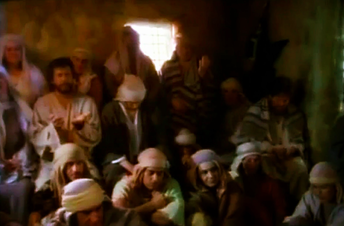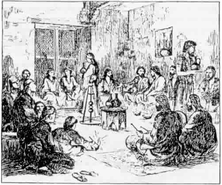 I don't smoke cigarettes . . . I don't go to the movies or the theater . . . I don't attend secular concerts . . . don't drink coffee . . . go to the beach . . . go dancing . . . fill in the blank. These lines and words are familiar to most evangelical and, especially, conservative Christians. Somehow these lines have been incorporated as a part of our idea of sanctification and how we take a stand against the world–in reality how we define ourselves and the world we oppose. For most of my Christian life I had understood some certain behaviors and places, some types of entertainment, and of course houses of ill repute were sinful, evil, and down-right ungodly–and no Christian should go or participate in such. There is a temptation, however, without some careful thought, biblical understanding, and wisdom, to identify certain activities and venues as evil, ungodly, and "pagan" (unChristian) in and of themselves–almost "just because" (and then attach a Bible verse). There is a tendency among us to simply think the early church condemned certain pagan and civil practices, prostitution, and entertainment because, somehow, such places and behaviors were inherently evil and ungodly. Don't worry, I haven't changed–much–on this thinking, but . . . consider where we might be missing the biblical (i.e., the gospel) point. I won’t dispute the notion entirely, but we need to ask why, what makes them evil and ungodly? In early Christianity, Nero (54–68) had accused Christians of being haters of mankind. Tacitus, a Roman senator and historian (c. 56 – c. 120), reflecting on Nero's post-Rome-burning activities, wrote in his Annals (c. 116):
Nero's indictment of the church caught on. The gathered-church and Christians were accused of being haters of mankind and antisocial (i.e., did not participate in the approved and appropriate Roman social activities). However, it wasn't just because there was something inherently evil, pagan, or sinful in pagan temples (of course idolatry is bad in any form), Roman theaters, religious brothels (there were no other at that time–really), and after-supper symposium entertainment (which included orgies, dancer-strippers, prostitution, and, as well, sexual encounters between adult men and pubescent or adolescent boys). The accusations had more to do with who was welcome at their table (literally), who made up the gathered-church, and how their faith (the gospel and the work of the cross) now defined the concept of being human. These "pagan" practices and venues were antithetical to the nature of the church and who was welcome to participate at the common meal, the Lord's table, and in baptism. The Christian community began to abstain from such activities–and their abstention and their gathering together as church was a challenge and a display of condemnation–because in the gospel and as a result of the cross, the leveling of humanity began to be practiced by the church (i.e., its habitus as a gathered-people). Children (boy and girls), women, slaves, and individuals of differing social, economic, and work classes took on new meaning, new intrinsic value, new dignity to each other "in Christ." Not all human beings were considered equally human or human at all. There was most definitely tiers of human hierarchies that placed a vertical understanding of people, human caste, occupations, age, gender, and ethnicity. When Christians were accused of repudiating and eschewing religious and pleasure practices and institutions of its day—i.e., the theater, temple prostitution, races, gladiator combat, household symposium entertainment—they did so primarily because these venues supported, displayed, and maintained the social and cultural tiers of human hierarchy (now that was and is evil)—not simply because somehow these things were inherently evil. They were venues and practices that supported and maintained social and cultural habits that were inherently racist, misogynistic, de-humanizing, child-abusive, women-abusive, enslavement (i.e., slavery), and thus maintained the evil and ungodly tiers of human hierarchy. All this was challenged by the gospel revealed in the cross and displayed by the gathered-church. This is why the early church was hated. They were accused of hating mankind and of being antisocial because the gathered-church by its very nature and habitus (i.e., how a church practiced being church and how that translated into daily, mundane life and human associations) challenged the status quo of the tiers of human hierarchy. This scared, frighten, and unsettled the gate-keepers, definers, and powers of the social order. I think, today, we're missing this element of a church's presence because of our Christendom-dependent, politically-aligning, homogenous, building-centered church experience doesn't create church in the same way the New Testament and early church was formed and acted. Through who we are as church and how we do church (in much of Christendom today), we have no power to challenge the very places and practices of racism, misogyny, child and women abuse, slavery (of any kind), and any form of de-huminzation of any gender, age, class, or person. Perhaps, it is time and appropriate to reconsider how we do church. For a thread on the nature of the gathered-church as God's platform for addressing and challenging the tiers of human hierarchy >> The Seditious gathered-church.
0 Comments
 The Leveling Story: Relistening to Narrative Choices that Formed the Gathered-Church The hermeneutical and interpretive value of narrative choices made by NT authors are often overlooked in forming our understanding of “church.” Such choices, particularly Luke’s in Acts, speak to the church’s formation and of its habitus (i.e., behaviors) that described who they were as a gathered-people (i.e., their social definition, associations among each other, and boundaries).[1] Here, I am selective, noting only a few narratives choices that highlight the formation of the household gathered-church as the gospel spread into the Gentile world. The Acts-House Movement, Day of Pentecost, and the case-study of Cornelius’ conversion. We should consider the hermeneutical and instructive nature of the church as a house movement. Although some early Christian witness occurred in the temple and synagogues, the NT is clear that the household-venue was the primary space of the local gathered-church. There are a number of texts indicating a gathered-church in someone’s house: . . . greet the church that is in their house (Rom 16:5); Greet those who are of the household of Aristobulus (Rom 16:10); Greet . . . the household of Narcissus, who are in the Lord (Rom 16:11); Aquila and Prisca greet you heartily in the Lord, with the church that is in their house (1 Cor 16:19); Greet . . . Nympha and the church that is in her house (Col 4:15); To Philemon . . . and to the church in your house (Phlm 1:1–2). Additionally, other texts affirm and indicate the formation of “household” as church (e.g., Eph 2:19–22; 1 Pet 4:17; 1 Cor 1:16; 16:15; Gal 6:10; 1 Tim 3:15; cf., 2 Tim 1:16; 3:6; 4:19; 1 Pet 2:5; cf. Acts 12:12; 14:27; 15:30; 20:7–8).[2] Furthermore, the gathered-church, depicted in NT narrative and biographical texts, did not invent, but adapted the typical Greco-Roman banquet-meal for their own household gathered-church venue (form). The banquet-meal typically divided into two-parts: first, a full meal (deipnon, supper) and, then, an after-meal symposium. The second component, among the Greeks and Romans, tended to be a prolonged time of drinking and entertainment, including speeches with discussion among the guests. The two components were bridged by a cup raised (or poured libation) of wine in honor of the Emperor with added praise or blessing of household deities, temple gods, and/or the benefactor or honored guest of the evening’s banquet.[3] The gathered-church, as it spread throughout the Greco-Roman world, celebrated the Lord’s Supper by breaking bread at the start to indicate the (broken) body of Christ now gathered, by enjoying a meal to which all were welcome (to recline at table), and, then, by lifting a cup of blessing in treasonous celebration of the risen (traitor, criminal, yet risen) messiah-king Jesus. Some imagine and describe the coming of the Spirit in Acts 2 as spectacular, more in keeping with a concert or stadium sporting event, than simply akin to someone’s family or dining upper-room. We speculate on the details, but we do know it started in a house (2:2c) and was evident to those who had gathered near, around, and outside that upper room (2:6). Greco-Roman banquet meals would have been somewhat public events,[4] where non-guests, a ring of on-lookers as it were, could easily observe the banquet event. So, it makes sense that onlookers would have observed the after-effects of the Spirit (cf., Acts 2:8–11). Amid non-guest reactions, some mocked, “They are full of sweet wine” (2:13). The reference to “sweet wine” was neither strange nor culturally unfitting. The gathering in the house’s upper-room would have been a household deipnon celebration (it was Pentecost after all) and potential drunkenness would not have been an incongruous assumption. Peter offered, however, an explanation (at the symposium?) by drawing on Joel’s promise of the Spirit. There was a plethora of OT Spirit-promises available to Peter, yet Joel 2 was chosen. Moreover, given the nature of speeches at that time, no doubt Peter was more verbose and quoted from elsewhere as well in his full Pentecost sermon. Still, these words are Luke’s narrative choice and should be seen as having hermeneutical and interpretive influence on our understanding of “church”: ‘And it shall be in the last days,’ God says, Albeit eschatological, the use of Joel 2 highlights a trajectory application meaningful for Luke’s formation of “church.” The issue of “tongues” (here known languages, Acts 2:6c) is intimately related to the redemptive turn that now all will hear of this gospel in their own language and the distribution of the Spirit would be on all demographics, social caste, gender, and age. In fact, Peter’s ending (Luke’s choice of ending) affirms this: And it shall be that everyone who calls on the name of the Lord will be saved (v. 21). After Peter’s message, the narrative, then, directs our attention (2:43–7) to the “added” believers (v. 47b) among households (i.e., house to house, 2:46b). The mention of “breaking bread” (v. 46b) and “meals together” (v. 46c) suggests the first gatherings took place at a household deipnon. The “added” that were continually devoting themselves to the apostles’ teaching (v. 42a) suggests the after-meal symposium was the venue for apostolic teaching. Thus, the first habitus of the newly formed gathered-church was shaped by the promised distribution of the Spirit across demographics, class, gender, and age within household-venues amid the celebration of food (a deipnon) and instruction (a symposium). The narrative choice of the Cornelius story, one of the longest in Acts (10-11), should be considered a second-Pentecost, for Luke records Peter’s explanation that the Spirit fell “just as He did at the beginning” (11:15; cf. 10:44–45). This repeat Pentecost affirms a trajectory application of the first (Acts 2). The Spirit falls, again, in a house (10:22; 11:12, 14), yet specifically a Gentile’s house. Typically, commentary follows Peter, that is, the apostolic reach into the Gentile world, in which when he preaches and the Spirit falls upon new believers outside of Jerusalem. However, it is Peter (i.e., and, thus, the reader) that is being taught something about the gospel and the church as they spread into the Gentile world. Luke’s telling of the story affirms this: When they heard this, they quieted down and glorified God, saying, “Well then, God has granted to the Gentiles also the repentance that leads to life” (Acts 11:18). [1] A local, gathered-church is assumed rather than a universal or invisible notion of “ekklesia.” When NT authors refer to a church they ordinarily mean a church gathered in a space, i.e., a venue, mostly a house.å [2] Other texts, although not using the word “church” imply a house-church (e.g., 2 John 1:10, . . . do not receive him into your house, and do not give him a greeting; Romans 14–15). [3] R. Alan Street, Subversive Meals: An Analysis of the Lord’s Supper under Roman Domination during the First Century (Eugene, OR: Picwick, 2013), 10. [4] The typical Greco-Roman banquet-meal and symposium was not open invitation, however, given the times, the gatherings would have been attended, yet not reclined at table, by outsiders who had gathered to observe. This is a thread consisting of parts of a a recent paper presented at the 2017 Evangelical Theological Society's annual meeting in Providence, RI. The goal is to develop an anthology of essays (by various authors) on the subject, Christian Responses to Tyranny. Part 1 | Part 2a | Part 2b | Part 2c | Part 3 | Part 3a | Part 3b | Part 4a | Part 4b | Part 5 For the entire thread (remember to scroll backwards for previous posts) << Gathered-church >>
In Ibram X. Kendi’s stellar volume on the history of racist ideas in America, Stamped From the Beginning, he argues for Aristotle’s influence on colonial Puritan politicians and preachers. And without hesitation, Kendi moves quickly back to early Christianity, linking the apostle Paul to the Aristotelian thread of “superior” demographics, the “three-tiered of hierarchy slave relations—heavenly master (top), earthy master (middle), enslaved (bottom).” Kendi, then, quotes Paul from Colossians 3:22: Slaves, in all things obey those who are your masters on earth, not with external service, as those who merely please men, but with sincerity of heart, fearing the Lord. Is this, however, a fair characterization of Paul’s view on slavery? Still, why didn’t Paul just simply condemn slavery outright? Moreover, why didn’t Jesus and the NT writers directly address the cultural and social oppression of women, children, and slaves? Yet, perhaps they had. Imagine, still, just maybe they had something more noble in mind? Arguably, it was the presence of Christianity in the Roman Empire that turned socially accepted tiers of human hierarchies and practices up-side-down, albeit slowly penetrating the social fabric of the Greco-Roman world through the formation of a household platform (literally) that inaugurated a social mapping revolution. Some cast early Christianity as a protest movement against an oppressive, imperial empire, yet the apostolic and early church lacked any power or leverage for such social and cultural revolution. New Testament writers did not seek to overthrow authority structures wherein the gathered-church inhabited. Nonetheless, the household gathered-church, along with their table-fellowship (i.e., the common meal/the Lord’s Supper) and other early gathered-church practices (i.e., household baptism and kiss), was the platform for making known God’s cosmic reconciliation. In this paper, I suggest it was the narrative of the gospel as it intruded upon the Gentile world in the midst of the local, household gathered-church that changed everything--that more noble idea. It is my thesis that the gospel let loose (applied and socially forming) among household gathered-churches changed existing social mapping, worked out through the habitus taught and implied (i.e., trajectory application) by NT teaching. My concern is to hear how relevant narrative choices in Acts speak to the household gathered-church and how its habitus resulted in new social-mapping (forms and habits) consistent with the gospel and the meaning of the cross. This is a thread consisting of parts of a a recent paper presented at the 2017 Evangelical Theological Society's annual meeting in Providence, RI. The goal is to develop an anthology of essays (by various authors) on the subject, Christian Responses to Tyranny. Part 1 | Part 2a | Part 2b | Part 2c | Part 3 | Part 3a | Part 3b | Part 4a | Part 4b | Part 5 For the entire thread (remember to scroll backwards for previous posts) << Gathered-church >>
|
AuthorChip M. Anderson, advocate for biblical social action; pastor of an urban church plant in the Hill neighborhood of New Haven, CT; husband, father, author, former Greek & NT professor; and, 19 years involved with social action. Archives
February 2024
Categories
All
|
Pages |
More Pages |
|

 RSS Feed
RSS Feed